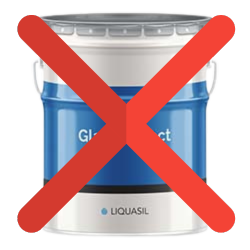
Rooflight Coating by Liquasil
We have discontinued our Glazeprotect rooflight coating.
The reason is because degraded rooflights can leak from stress cracks around fixings, or because of poor seals. A coating cannot fix these defects.
Our recommendation since we started Liquasil, has been to replace GRP and Polycarbonate roof lights on industrial buildings wherever possible.
Whilst rooflight coatings are guaranteed, the guarantee applied only to the product itself. Leaks from fixings, holes, cracks or poor seals will not be covered.
Therefore, it makes far more sense to replace rooflights than to coat them.
New rooflights will be guaranteed by the manufacturer for up to 20 years.
All new seals and fixings will be provided and this results in a longer-lasting and far more resilient solution than coating.
Yes, we could sell you a coating if you absolutely insist, but our experience of industrial roofing, gained over many years from our Chartered Building Surveying practice tells us that in most cases, it’s a false economy.
Replacing the outer skin of a roof light is no more expensive than coating it.
Why You Should NOT Coat Rooflights
We have discontinued our Glazeprotect rooflight coating because we firmly believe there is little advantage to building owners in coating rooflights.
Whilst it might take less time to coat a rooflight, as opposed to changing it, in cost terms, there is a actually not that much difference.
If the original gel coat has degraded to the point where the glass fibres are clearly visible and heavily soiled, or are cracked or holed, we strongly recommend replacement rather than coating.
If the rooflights are not degraded, then why bother doing anything with them?
Before coating rooflights, they first need to be cleaned thoroughly and the most common method is to use jet washing equipment.
Extreme care needs to be taken when cleaning GRP rooflights, because high water pressure can easily cause further damage, or even destroy a GRP or polycarbonate rooflight.
This is the correct procedure if you do decide to coat rather than replace rooflights:
-
-
- Apply a fungicidal wash to entire surface and allow to remain on the rooflight for 24 hours.
- Thoroughly wash the rooflight using a car-cleaning or similar type brush and clean water.
- Allow surface to dry thoroughly.
- Apply coating as per manufacturer’s instructions.
-
Rooflight coatings are available from other manufacturers, but only Liquasil recommends replacement over coating, because of our background in building surveying.
Please note that despite what others might claim, if a rooflight is cracked or holed, it should be replaced, because a coating is only as good as the surface it is being applied to.
For further guidance, call us on 0121 709 5352.
We’ll happily look at your photographs and provide an indication as to whether your rooflights should or shouldn’t be coated.
Liquasil manufactures and sells roof coating products.
Whilst we could make more money by selling you a rooflight coating, we prefer to provide the correct advice.
Replacing your rooflights is a always better option than coating.
Please call 0121 709 5352 for more information on industrial roof coatings.
